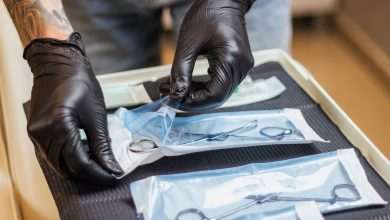The Ultimate Guide To Men’s Boots Maintenance: Cleaning, Care, And Preservation

Keeping your boots in top condition is not just about preserving their appearance; it’s also about ensuring their longevity and functionality. Whether you wear boots for work, outdoor activities, or as a fashion statement, proper care and maintenance are essential.
Whether you’re an outdoor enthusiast, a hardworking professional, or simply someone who appreciates a great pair of boots, it’s important to learn how to take good care of your boots, especially if it’s as special as the men’s boots from the UK that I bought some time ago. Looking for the best advice and techniques for boot care and maintenance will help you extend the life of your boots, keep their appearance, and enjoy their comfort and functionality for many years to come.
Understanding Boot Materials and How to Maintain Them
Before delving into the intricacies of boot maintenance, it is crucial to understand the different materials used in the construction of men’s boots. Each material has its unique characteristics and care requirements, which influence how you should clean, condition, and preserve your boots. Below are the various boot materials commonly found in men’s footwear, and the suitable maintenance methods for each.
Leather Boots
Leather boots are timeless classics appreciated for their durability, style, and versatility. They come in different types of leather, such as full-grain, top-grain, and suede.
Full-grain leather is known for its natural imperfections, strength, and ability to age beautifully. Top-grain leather has a smooth finish and is often treated for enhanced durability and resistance to wear. Suede leather boasts a velvety texture but requires special care due to its delicate nature.
Key care considerations for leather boots include regular cleaning to remove dirt and stains, conditioning to keep the leather soft and supple, and polishing to maintain its luster. Understanding the type of leather used in your boots is crucial, as it determines the appropriate cleaning agents, conditioners, and polishes to use. In addition, you should consider the following when cleaning your leather boots:
- Use a soft brush or cloth to remove loose dirt and debris.
- Use a leather cleaner specifically formulated for your type of leather, applying it with a damp cloth or sponge.
- Gently rub the cleaner in a circular motion, paying attention to the stained areas. Rinse the cloth or sponge and wipe away the cleaning solution.
- Air dry the boots, but make sure to keep them away from direct heat or sunlight.
- Keep the leather moisturized and prevent cracking by applying a leather conditioner on its surface.
Synthetic Boots

Synthetic materials, such as faux leather or synthetic fabrics, are commonly used in boots. These materials offer various advantages, including affordability, water resistance, and ease of maintenance. Synthetic boots often require less maintenance compared to their leather counterparts.
Cleaning synthetic boots typically involves gentle wiping with a damp cloth or mild soap solution to remove dirt and stains. However, it is essential to refer to the manufacturer’s instructions for specific care recommendations, as some synthetic materials may have unique requirements. Cleaning synthetic boots usually involves the following steps:
- Wipe away surface dirt with a damp cloth or sponge. For stubborn stains, use a mild soap solution and gently scrub the affected area.
- Rinse the boots with clean water and wipe away excess moisture with a dry cloth.
- Allow them to air dry naturally.
- Avoid using harsh chemicals or abrasive cleaning agents, as they may damage the synthetic material.
Suede Boots
Suede boots have a luxurious and soft texture that adds a touch of sophistication to any outfit. To preserve the appearance of suede, however, specialized care is required. Unlike leather, suede is more prone to water damage, stains, and scuffs.
Maintaining suede boots involves regular brushing with a suede brush to remove dirt and restore the nap. It is crucial to avoid exposing suede boots to water and use specialized suede cleaning products and protectors to shield them from stains and moisture. Follow these step-by-step process:
- Start by using a suede brush or eraser to remove surface dirt and restore the nap. For stains, gently rub the affected area with a suede cleaner or a mixture of vinegar and water.
- Allow the boots to dry naturally and then brush them again to revive the suede’s texture.
- To maintain the suede’s softness and protect it from stains, apply a suede protector spray according to the manufacturer’s instructions.
Other Materials
In addition to leather, synthetic materials, and suede, men’s boots may feature other materials such as canvas, nylon, or rubber. These materials often serve specific purposes, such as providing breathability, flexibility, or added protection. Cleaning and maintaining boots made from these materials may involve gentle washing, spot cleaning, or using specialized cleaning products recommended by the manufacturer.
Boot Storage and Preservation: Tips for Boot Longevity

Proper storage and preservation of your boots are crucial for maintaining their shape, preventing damage, and extending their lifespan. Whether you’re storing them during off-seasons or when they’re not in use, following the right practices will ensure that your boots remain in optimal condition. These effective strategies for storage and preservation include the following:
- Clean Before Storing. Follow the appropriate cleaning techniques discussed earlier in the guide to remove any surface grime. Cleaning prevents the accumulation of debris and potential damage during storage.
- Maintain Boot Shape. Maintaining the shape of your boots is essential to prevent unsightly creases and deformities. Consider using boot trees or inserts made of materials like cedar or plastic to help retain their shape.
- Avoid Moisture and Humidity. Moisture and humidity can lead to mold, mildew, and deterioration of your boots. If your storage space is susceptible to moisture, use moisture-absorbing products like silica gel packs or desiccants.
- Protect from Sunlight and Heat. Direct sunlight and excessive heat can cause fading, cracking, and drying out of the materials. Store your boots away from windows or heat sources.
- Regular Inspections. Even during storage, periodically inspect your boots for any signs of damage, pests, or deterioration. Catching issues early on allows for prompt repair or preventive measures.
Preserve, Protect, and Enjoy Your Footwear to the Fullest
Remember that proper maintenance is not a one-time task but an ongoing commitment. Regular cleaning, conditioning, and protection from the elements are vital to preserving the quality and integrity of your boots.
Additionally, investing in high-quality boot care products and tools, such as brushes, conditioners, polishes, and waterproofing agents, will aid in your maintenance routine and ensure optimal results. If you are uncertain or dealing with delicate or high-end footwear, seeking professional advice or consulting a cobbler is recommended.



